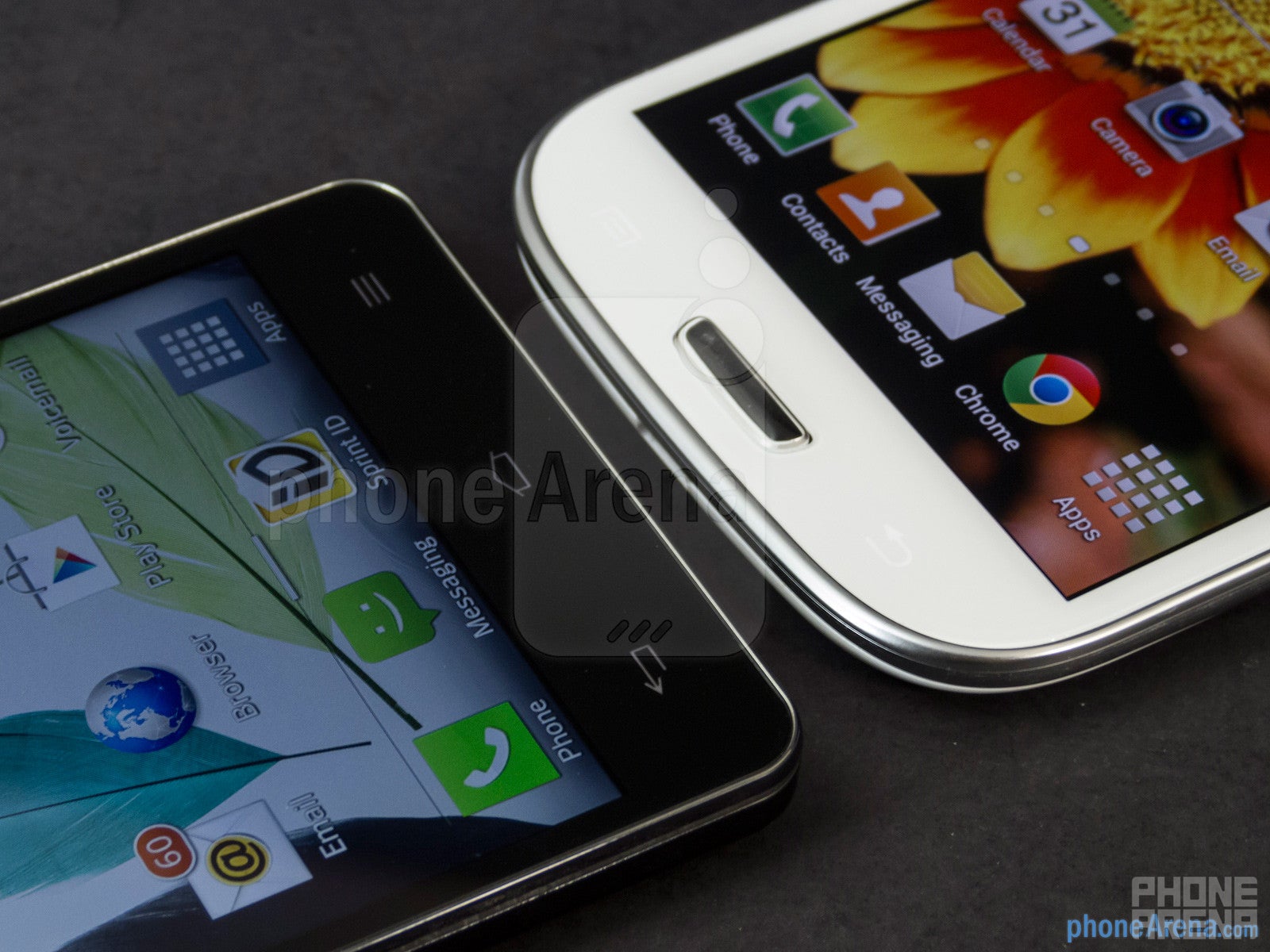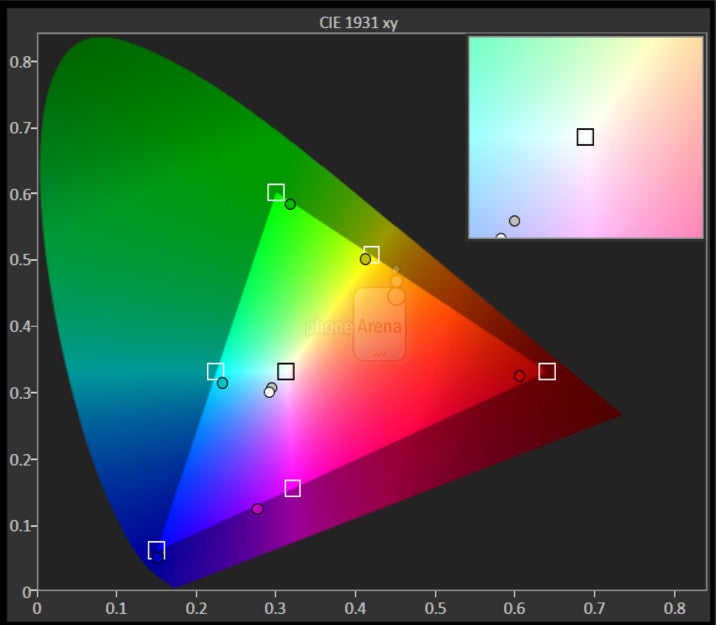LG Optimus G vs Samsung Galaxy S III

For this comparison, we are using the Sprint versions of the two phones.
Introduction:
Continuing its reign atop the Android world, the Samsung Galaxy S III has been one polarizing smartphone that has captivated us with its all-encompassing high-end goodness. Lurking in the shadows waiting for its turn to burn up the scene, the LG Optimus G is gearing up to finally make its attack in grabbing the crown. Being the newer kid on the block, the Optimus G’s combination of featuring a quad-core processor and 4G LTE connectivity makes for one alluring tally at the moment, but will it be enough to conquer the tight grasp that Sammy’s flagship has on the market?
Design:
Honestly, it’s rather tough to say which design we like better. On one side, we like the lightweight, minutely smaller frame, and more natural feel in the hand we get out of the Samsung Galaxy S III. In comparison, we’re attracted to the LG Optimus G’s more premium materials and solid construction – attributed to its Crystal Reflection rear pattern and layered glass surfaces. Essentially, we’ve got one solid dark slab with LG’s offering, while Sammy’s pride and joy comes off as a polished stone. Either way, we definitely like the designs of both.

The capacitive buttons below the screens
Interestingly enough, the placement of their power buttons and volume controls are identical – while at the same time featuring the same distinct feel and responsive touch when pressed. Taking a peek around the trim of both smartphones, they feature 3.5mm headset jacks, microphones, noise-cancellation mics, and microUSB ports for data/charging/video-out connectivity.
Display:
We’ll hand it to the Samsung Galaxy S III for having the showroom wow factor with its 4.8” HD 720 x 1280 Super AMOLED display, due to the enchanting overly saturated color tones and the deep blacks of its screen. Packing some heat of its own, the LG Optimus G stands out magnificently as well thanks to its 4.7” WXGA 768 x 1280 HD IPS Plus display, but unlike its rivals, its color tones are more natural and realistic. Even though LG’s offering is utilizing the more favorable RGB sub-pixel arrangement, as opposed to the PenTile matrix arrangement of the SGSIII, we don’t find one that’s considerably better when it comes to raw details. However, it’s the superior outdoor visibility of the LG Optimus G’s IPS display that enables it to inch out ahead.
Interface and Functionality:
Now here’s where it gets cooking, seeing that LG has finally accomplished some remodeling work with its custom Android experience. At their core, the two opposing custom UIs offer all the foundational aspects of the platform that we adore – like its deep personalization and wealth of widgets. Beyond that, there are stark similarities between their additional features, but when it comes down to it, we find Samsung’s TouchWiz Nature UX to be the deeper, more comprehensive, and practical between the two. Honestly though, we appreciate the evolutionary improvements made with LG’s effort, like its QSlide, Dual Screen/Dual Play, and Live Zooming features, but we find Samsung’s wealth of offerings to be more refined and developed. Specifically, S Voice, S Beam, and Share Shot are some of the myriad of cool features that are not only practical for real-world usage, but the execution is there as well in making it useful for everyday situations.
Taking a quick peek at the core set of organizer apps of both handsets, there’s nothing different about them except for their slightly different looks – albeit, their functions are identical. Furthermore, there’s nothing too out of the ordinary with the native email apps on both devices, as they prove useful in making us extremely productive on the go. However, there are some specific features that stand out with the two – like the screen zooming feature with the LG Optimus G and the “select all” function found with the Galaxy S III. Then again, the Gmail experience is 100% identical.
Giving us plenty of room for our thumbs to play around with, the on-screen keyboards of both Android smartphones enable us to accurately type messages with minimal mistakes. Not only are we presented with spacious layouts, their responsiveness enable us to maintain a steady rate of input.
Processor and Memory:
From a cursory look, one would hardly notice the difference in performance between these two Android titans – mainly due their super responsive actions with all tasks. Whether it’s basic tasks like opening apps to more complex ones like gaming, the two are no doubt on the same pace to each other, but as we meticulously compare the two, we do notice more of a snappy feel with the LG Optimus G. In addition to that, its benchmark scores really tell the true story in how its quad-core 1.5GHz Qualcomm Snapdragon S4 Pro processor with 2GB of RAM is more effective in executing tasks with a sense of rapidness than the Samsung Galaxy S III’s dual-core Qualcomm Snapdragon S4 processor with 2GB of RAM.
With the Sprint versions of the two handsets that we’re checking out, the Samsung Galaxy S III coughs up the usual 16GB of RAM out of the box, which can be supplemented by its microSD slot. The same goes for the AT&T Optimus G. Oppositely, the Sprint LG Optimus G has only 32GB of internal storage with no expandability.
Internet and Connectivity:
Let’s be serious here people, even though there’s an advantage with the LG Optimus G’s quad-core processor, it doesn’t necessarily prove to be a deciding factor in the web browsing experience. In fact, the experience is simply dreamy with the two smartphones, since they offer speedy 4G LTE connectivity and those always-lovable fluid navigational controls. Heck, even relying on their stock browsers that support Flash, they’re able to maintain a responsive performance throughout it all.
Very well known at this point, we know that there are many variants of the two smartphones in this comparison, which means that they’re both available in GSM and CDMA forms – with 4G LTE connectivity in tow as well. Moreover, they share many of the same connectivity features as well, like aGPS, Bluetooth 4.0, Wi-Fi, mobile hotspot functionality, and NFC.
Camera:
For the camera-centric folks out there, these two don’t disappoint as the Samsung Galaxy S III is packing an 8-megapixel snapper – whereas the Optimus G is being more aggressive with its 13-megapixel camera on the Sprint version or 8MP on the AT&T model. Naturally, both are complemented with LED flashes and 1080p high definition video recording. Conversely, it’s the Galaxy S III flaunting the higher 1.9-megapixel camera in the front – with the Optimus G being outfitted with a 1.3-megapixel one.
Despite finding a higher 13-megapixel count camera on the LG Optimus G, we don’t find its quality to be any better than the results put out by the Samsung Galaxy S III’s8-megapixel snapper – they’re nearly identical in all aspects actually! Well, that’s not a bad thing to find, but obviously, some people would anticipate seeing better results with the higher megapixel count and new LG Optimus G. As a whole, they definitely take some pleasant outdoor shots, but when it comes to indoor and low lighting situations, they exhibit the same flaws. Specifically, they’re unable to manage dynamic range – resulting in over-exposure and loss of details with brightly lit areas. However, we have to mention that the Galaxy S III’s LED flash execution is better since it turns on prior to taking the shot, resulting in better focus and sharper visuals.
Even though it’s a close race in the still image department, when it comes to high-definition 1080p video recording, Sammy’s flagship shows us that it’s the more preferable device for the occasion. Winning in almost every noteworthy area, Sammy’s smartphone delivers the goods with its more crisp details – whereas it’s a bit more faint and soft with the LG Optimus G. Furthermore, LG’s offering is plagued by more heavy artifacting when panning.
LG Optimus G Sample Video:

Samsung Galaxy S III Sample Video:

LG Optimus G (Sprint) Night Sample Video:

Samsung Galaxy S III Night Sample Video:

Multimedia:
Strange to say, their native music players lack the visual allure to make them stand out versus other offerings, but of course, the Google Play Music app with its snazzy visuals are available on both as an alternative. When it comes to the audio quality of their speakers, we don’t notice one to be superior than the other, since they produce strong volumes that are pleasant to the ear for the most part.
When it comes to the video watching experience, it’s really a tossup because it’ll depend on what you find to be more attractive. In terms of commonalities, they’ve got large screens and smooth playbacks to make the experience gratifying, but it’ll depend on whether you prefer the saturated tones of the Samsung Galaxy S III or the more accurate ones of the LG Optimus G. Simply put it, they’re both wonderful in this aspect.

As we’re checking out the Sprint versions of the two handsets, we have to admit that the Samsung Galaxy S III fares better in the call quality department, mainly because of the clear and audible voices we’re presented with on both ends of the line. With the LG Optimus G though, it’s plagued with some minor hollow voices through the earpiece and muffled voices on our callers’ end.
Battery:
Somewhat of a strange coincidence, these two admirable smartphones are tucking away 2,100 mAh batteries within their bodies. And to tell you the truth, we find their battery life performance to be on par with one another – getting us through a solid day of normal usage with a full charge. Still, it’s worth noting that the results are based on our experience using the two with 3G EV-DO connections, as opposed to 4G LTE.
Conclusion:
Clearly folks, it’s nearly a dead heated tie with these two juggernauts in the Android realm, seeing that they perform extremely close to one another. However, if we factor in price point into the mix, one would assume that LG’s offering would be the one delivering the most bang for the buck – especially taking into account the quad-core processor it’s packing for the ride. However, we feel as though Samsung has placed enough emphasis in the software experience to still push it slightly ahead of the LG Optimus G. Ultimately, you won’t go wrong siding with either device, but Sammy’s pride and joy seems to have that balanced performance and set of features to continue fending off its competition at the moment.
LG Optimus G vs Samsung Galaxy S III Video Comparison:

LG Optimus G vs Samsung Galaxy S III Video Comparison:























Things that are NOT allowed: